These two stockpots are cousins, not siblings.
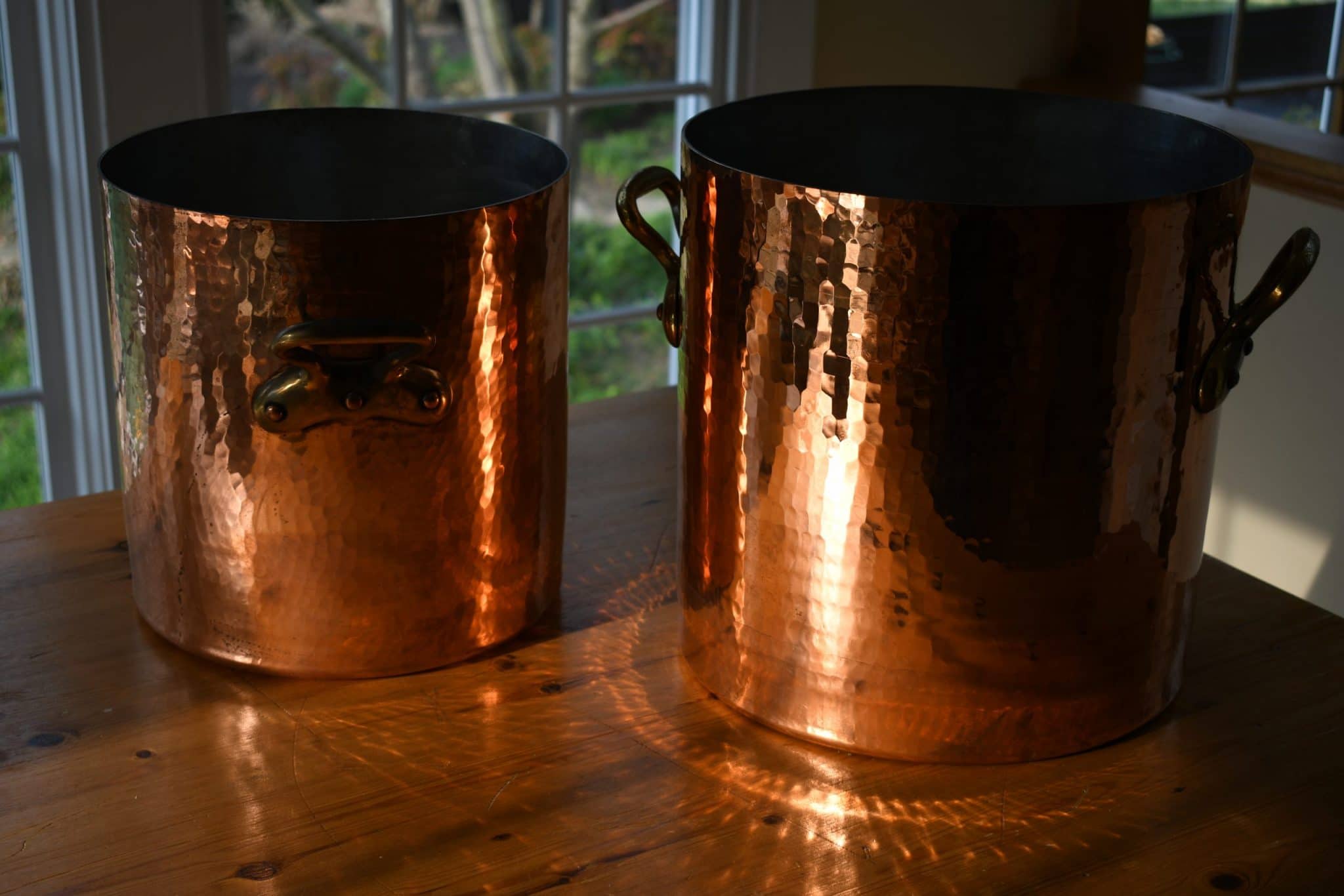
| Type | Two tin-lined stockpots in hammered finish with brass handles fastened with three copper rivets; fitted brass lid handles fastened with one copper rivet on each side | |
| French description | Deux marmites traiteures étamées et martelées avec poignées en laiton munies de trois rivets en cuivre; couvercles emboîtés avec poignées en laiton munies d’un rivet en cuivre sur chaque support | |
| Dimensions | 26cm diameter by 26cm tall (10.2 inches by 10.2 inches) |
32cm diameter by 32cm tall (12.6 inches by 12.6 inches) |
| Thickness | 1.5mm at rim | 2.5mm at rim |
| Weight | 4630g (10.2 lbs) without lid 5562g (12.3 lbs) with lid |
9940g (21.9 lbs) without lid 11156g (25 lbs) with lid |
| Stampings | MADE IN FRANCE | [Bonjour logo] MADE IN FRANCE |
| Maker and age estimate | Mauviel; 1960s to 1980s | Mauviel; 1980s to 2007 |
| Source | FrenchAntiquity | Harestew |
These stockpots are both the work of Mauviel and therefore were built at the same factory in Villedieu-les-Poêles in Normandy. The craftsmanship involved is identical: copper sheets were cut to measure, soldered together, and hammered; brass handles were affixed with copper rivets. This same technique (plus or minus some sheet-cutting, soldering, and riveting machines) is unchanged for most of the 20th century. And yet, when I look closer, I see some differences that tell me that these pots were built during different decades.
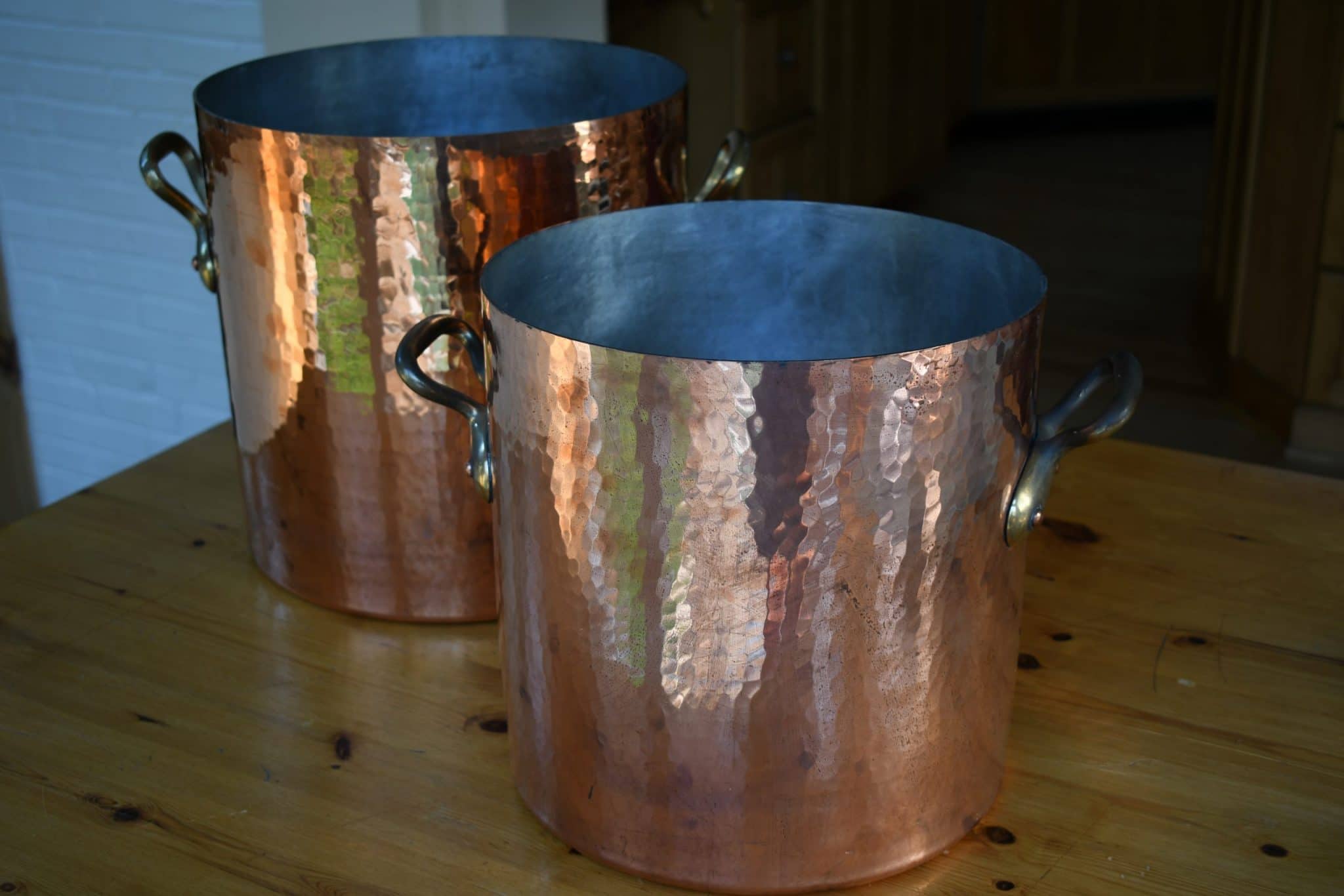
When I’m trying to figure out when a big piece was made, the first thing I look for are the seams. Many small pots and pans can be shaped by machines that bend the metal into shape, but larger pieces like daubières, stockpots, and large-scale rondeaux are pieced together from sheets of copper and then the seams are sealed. In the modern era, those seams are soldered, but up until the turn of the 20th century the seams were cramped (or dovetailed) and then brazed with brass, leaving tell-tale lines of yellow metal.
Both of these pots have welded seams. They’re subtle, as the welding fuses the copper very neatly, but you can find them if you look an inch or two above the base of the pan. Here’s a closeup of the soldered seam on the 32cm.

Differences begin to emerge on examination of the handles and rivets. The handle baseplates are shaped slightly differently — look on the lower edge of the baseplate. The exterior rivets look identical but the interior rivet heads are different: the 26cm rivets are featureless, while the 32cm rivets have numbers on them. Someday I will figure out what the numbers mean, but a common-sense conclusion is that the numbers refer to specific dimensions of the rivet and would help with sorting in the shop.

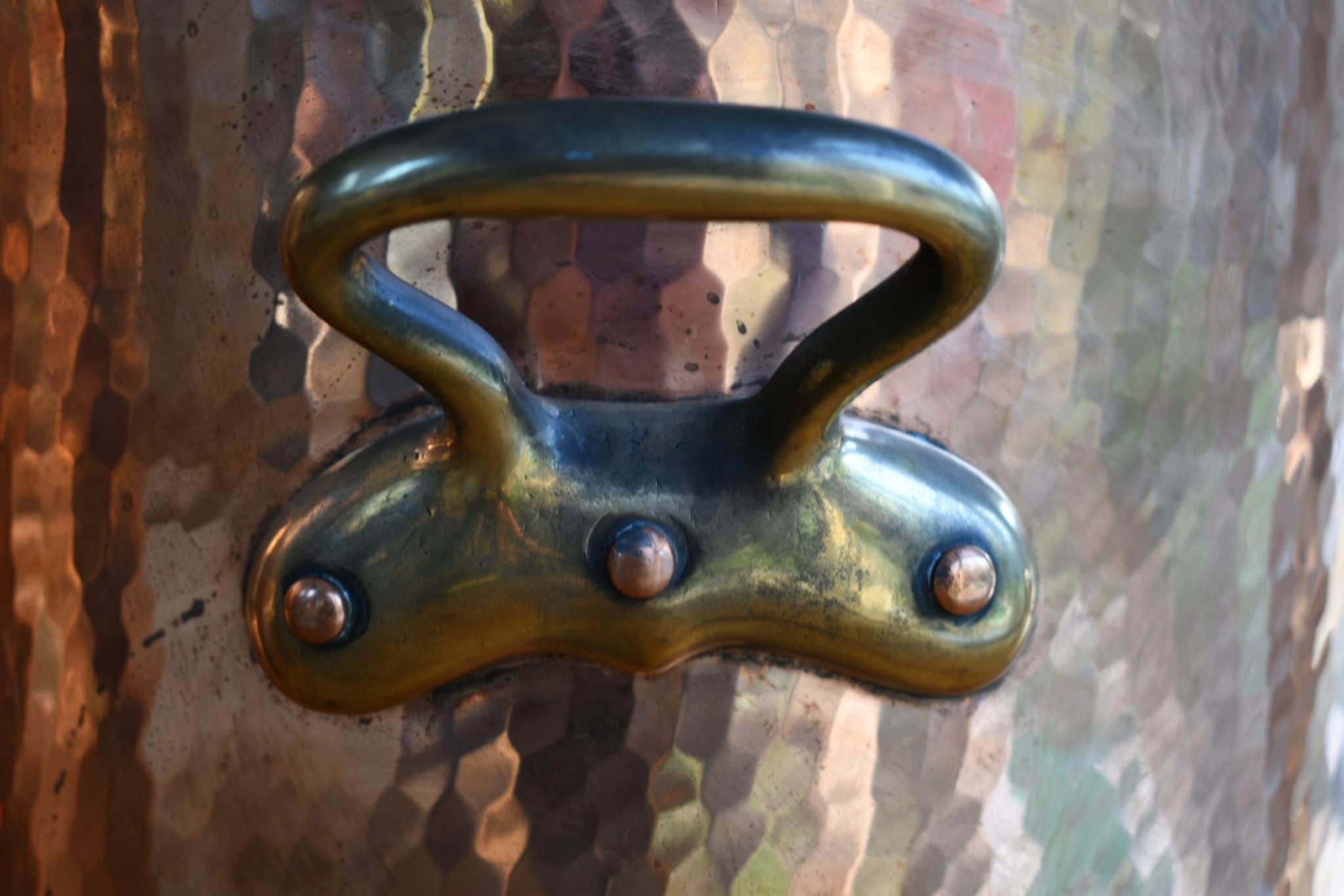
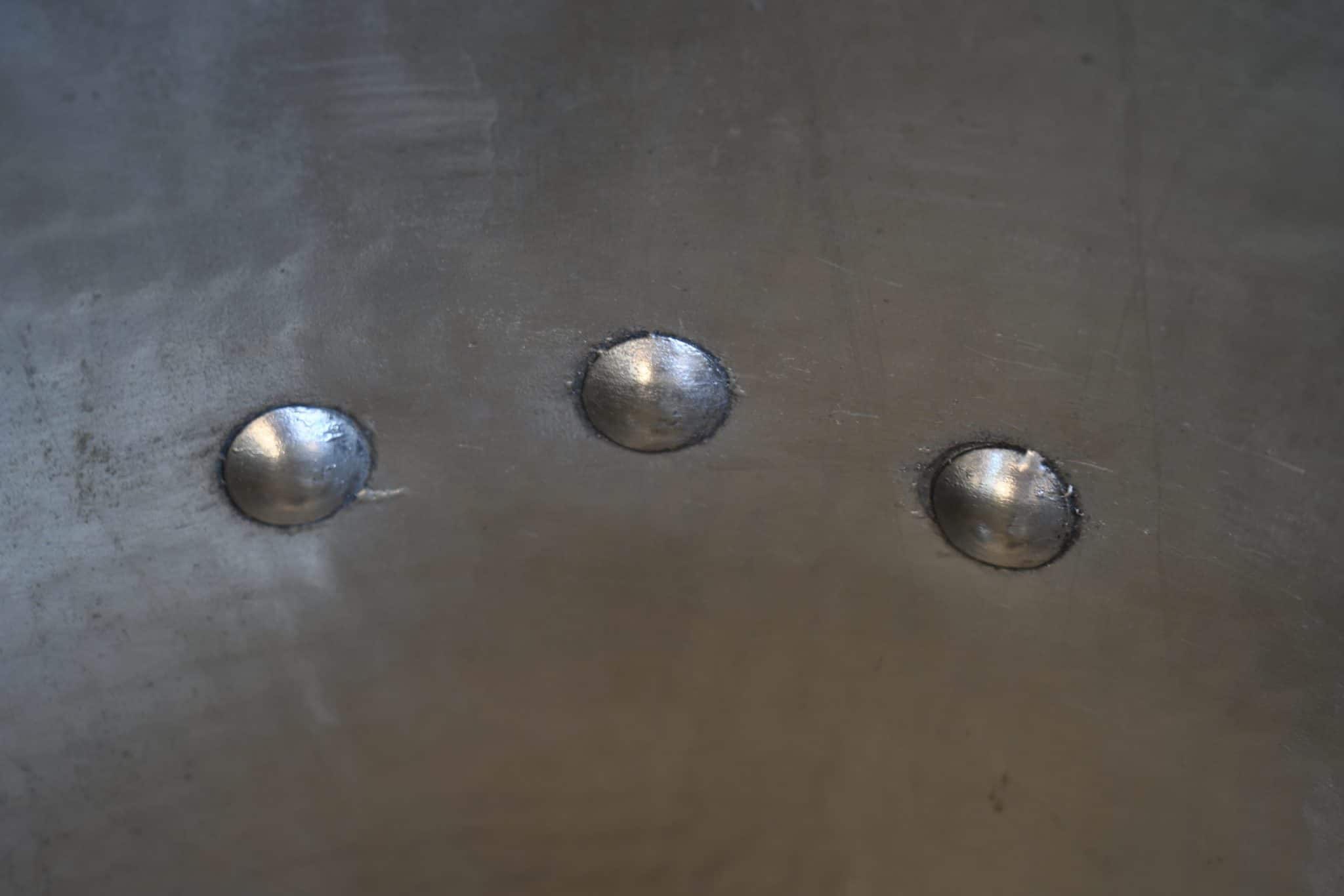
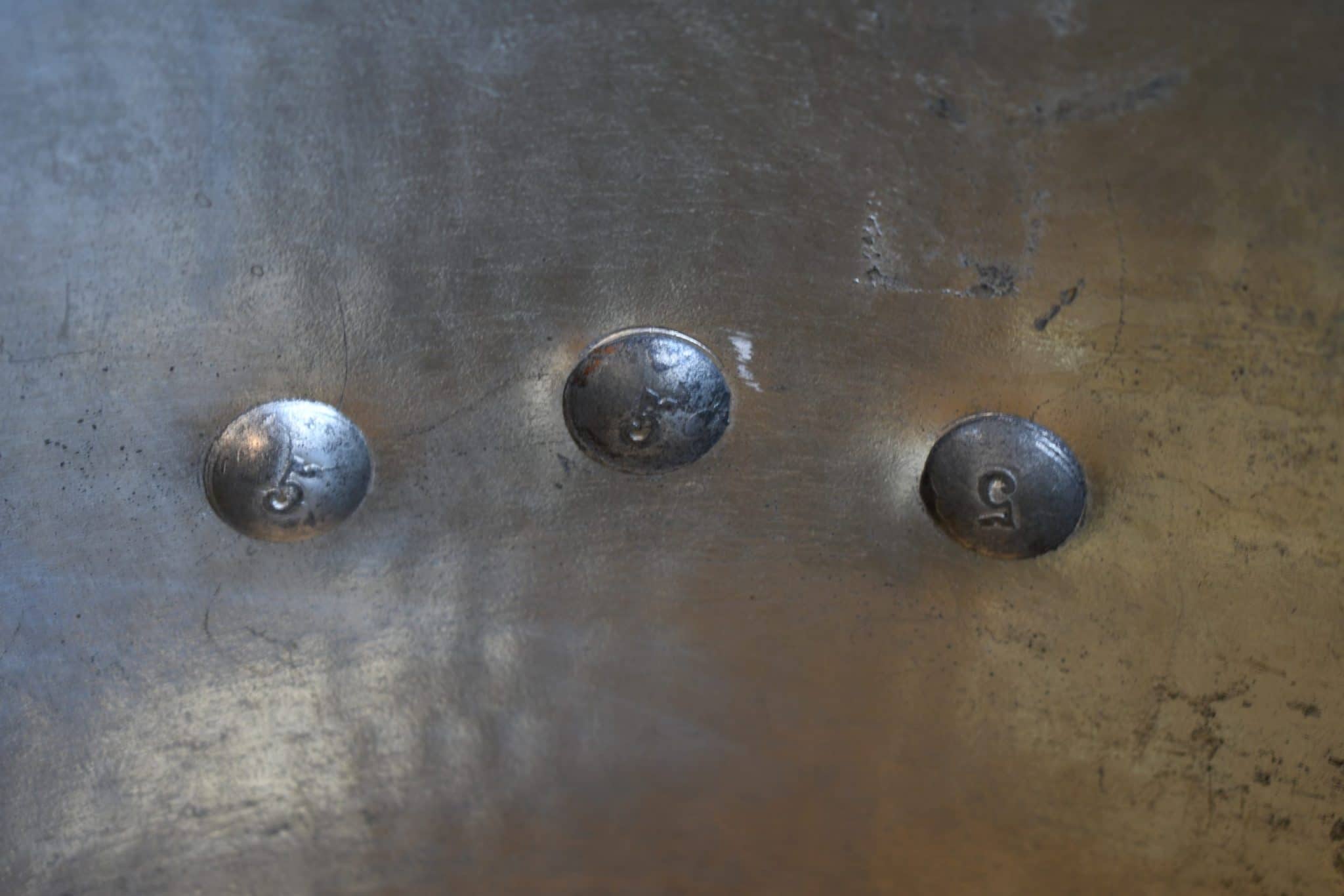
The handle and rivet details above are not super helpful for dating the pots specifically, at least based on my current knowledge. Rather, they indicate different production runs of cast handles and batches of rivets. I don’t know how far apart the runs were, of course, but my current guess is that these pots could be 20 years apart in age or so.
The lid handles are also slightly different, but I’m not attaching great significance to this. Lids are often sold separately, lost, or replaced, so in most cases a lid is not a reliable indicator of age. (The exception is a lid that is stamped with a maker’s mark, owner’s mark, or size mark identical to that on the pan body.) These are standard Mauviel lids of different modern eras — the 26cm brackets have a smoother look than those for the 32cm lid.

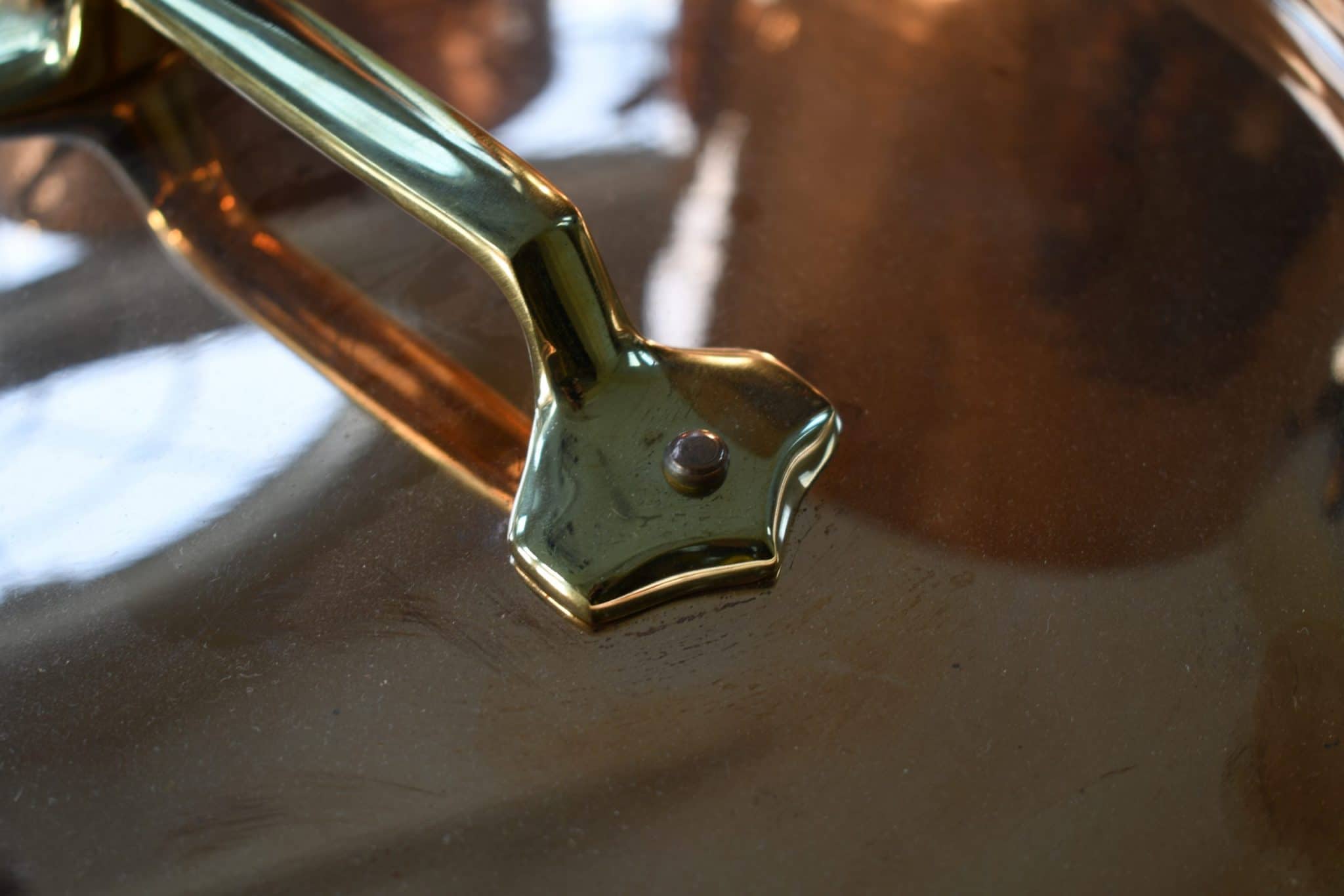
The pots carry different stamps. The 26cm carries a generic “MADE IN FRANCE” stamp, which dates it to the 1960s and later. The 32cm was made by Mauviel for sale at the Bonjour kitchen store.

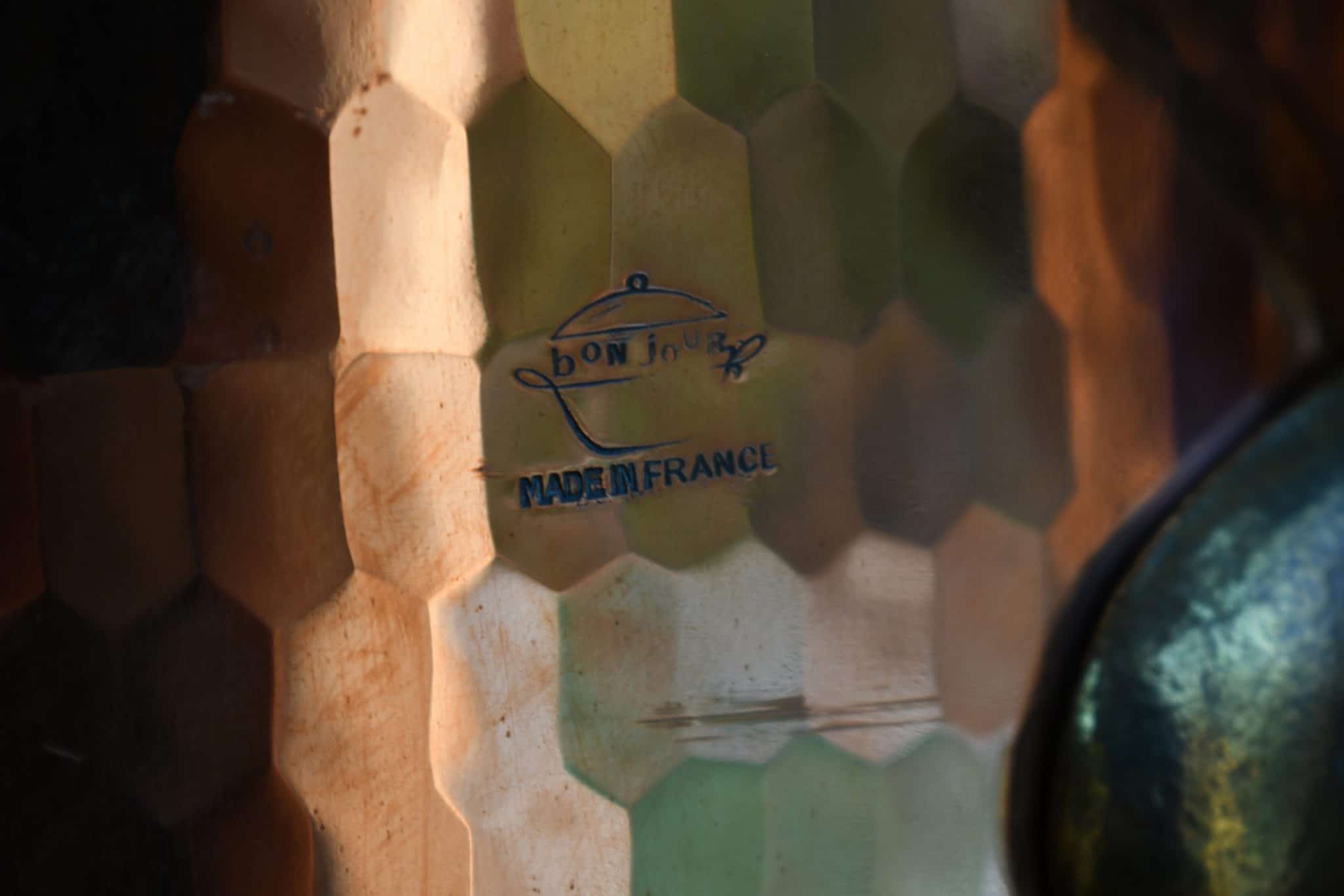
But it is the hammering that has me intrigued. Look at the pattern on the 26cm next to the 32cm.

When I look closely at each pattern, I see a difference in the alignment of the hammer strikes. It’s subtle, but to me it indicates a difference in technique between the two pots. They were both machine-hammered, but you can see how different craftsmen positioned the marks.
Take a look at these detail photos below. I traced the vertical alignment of hammer marks; the 26cm hammer marks overlap vertically, but the pattern drifts to the side, and by contrast, the 32cm hammering is more like a honeycomb, and there is less sideways drift.
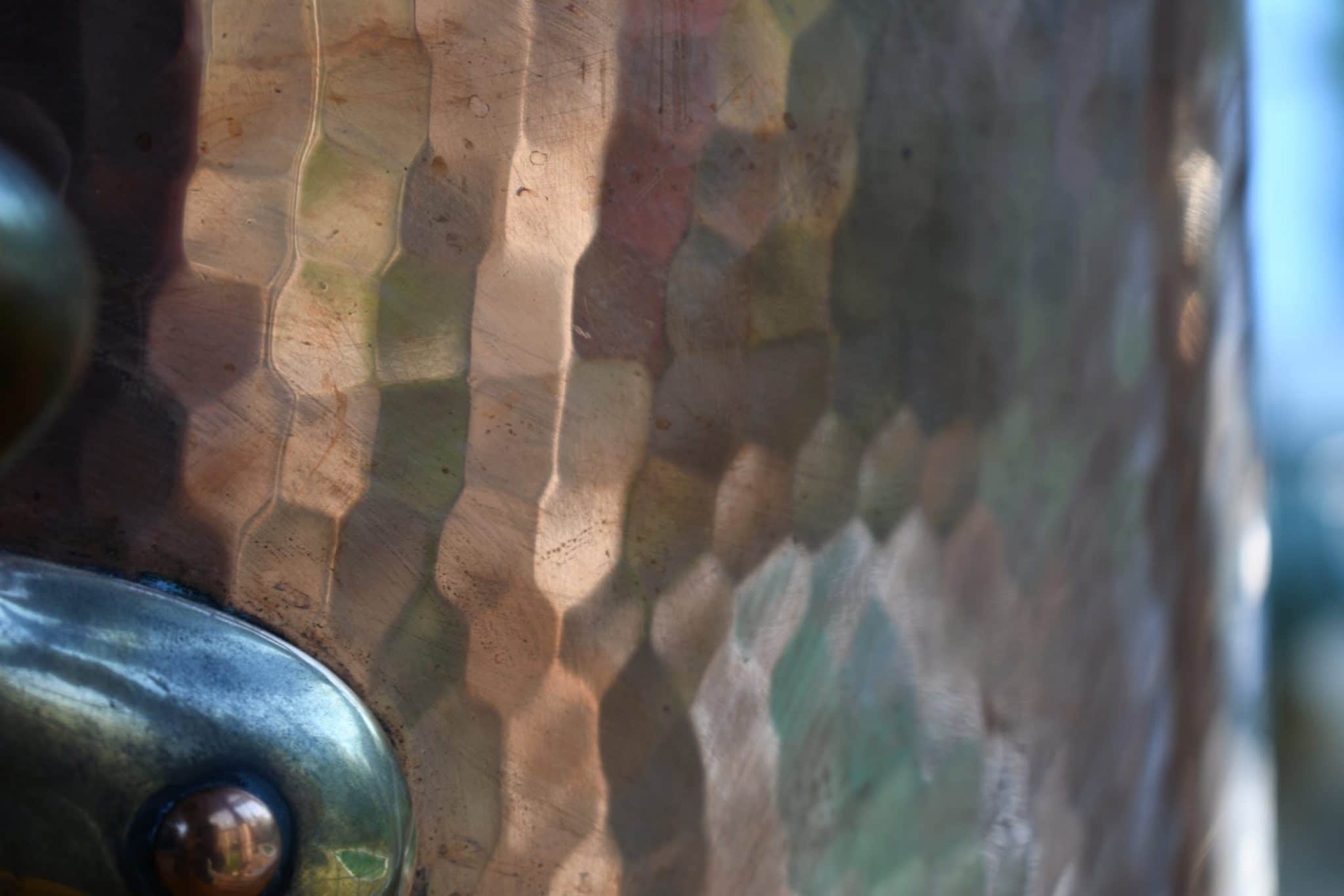
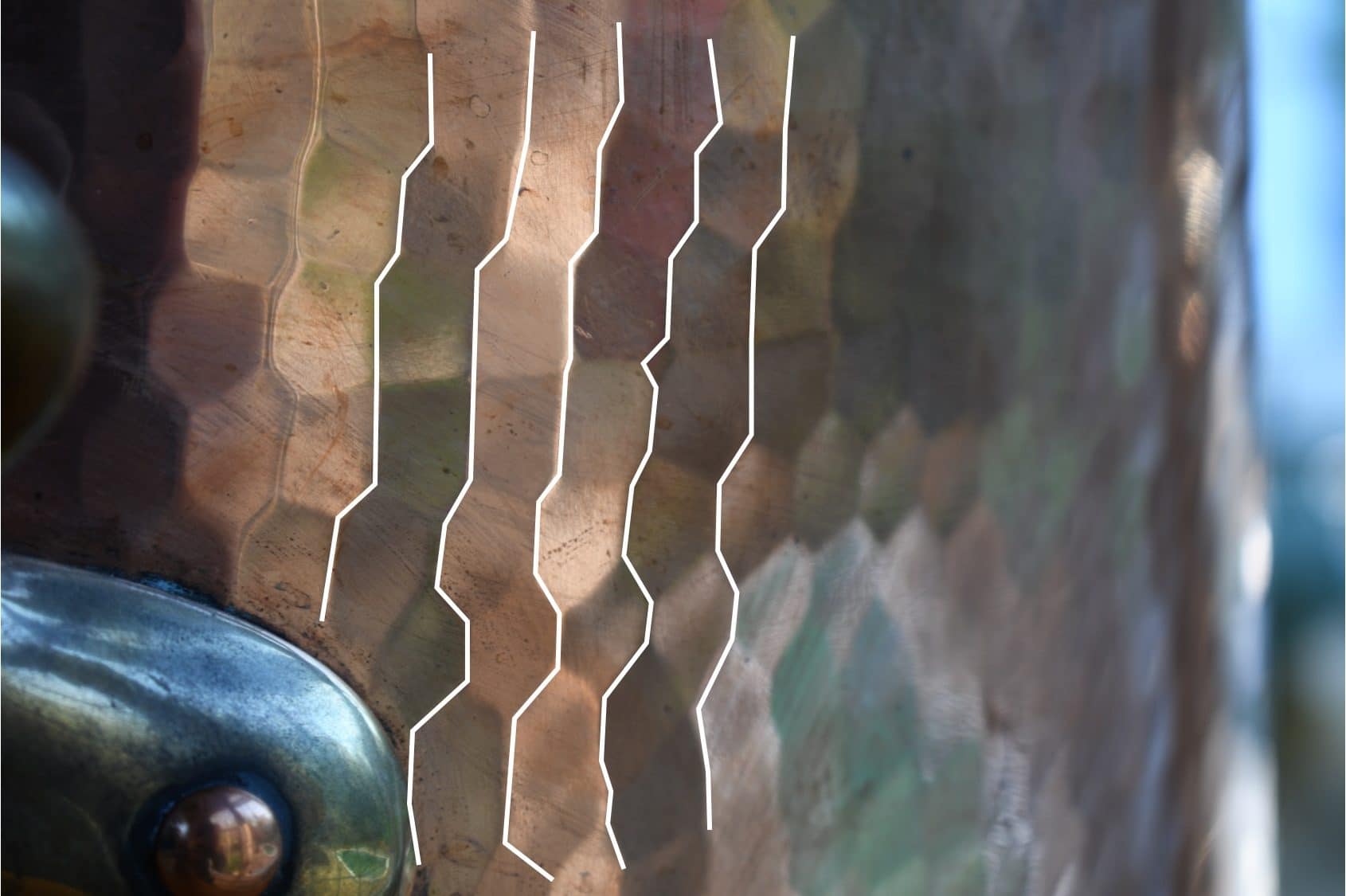
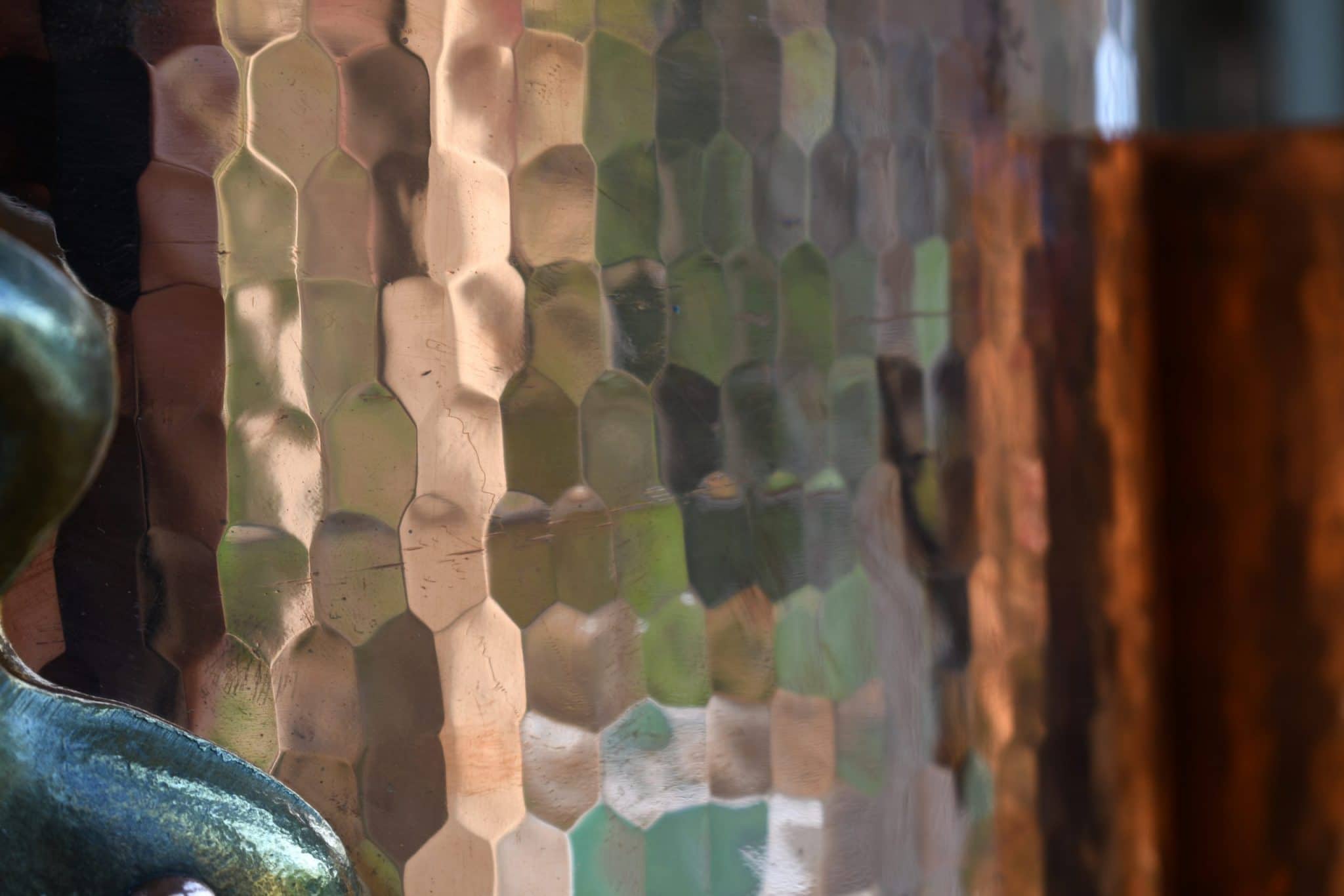

This difference comes down to the craftsman’s decisions to reposition the pot under successive strikes from the hammering piston. But there’s another possibility: hand-hammering. Would large vessels like these two stockpots have been too deep to fit around the hammering machine? Could the differences in hammering patterns reflect actual hand-hammering?
Mauviel’s factory video from 2017 shows both hand-hammering and machine-hammering — zoom to about 1 minute 55 seconds into this video. The sequence is only a few seconds long, so keep your eyes peeled, but it shows a craftsman hand-hammering a daubière, and then in the next shot, a craftsman using a hammering machine on a skillet.
This hammering stuff is a bit inside baseball, I know, but these physical artifacts reveal something of the craftsmanship of copper, and I’m frustrated by how little information there is about this stuff. And again, this is just a theory of mine — I have no facts (yet) to back up this idea that the slightly irregular hammering could be the sign of slightly irregular hand-work. If you know better, please comment! I’d love to learn.







The Mauviel video shows both hammering techniques being used by the craftsman: were both used concurrently, or does the hand-hammered technique only exist on older pots, to be rendered obsolete by the late 20th century—and thus furnishing a reliable way of dating the pots.
Both stockpots are beautiful in their different ways. The even honeycomb machine-hammering of the newer 32 cm pot is more restrained while the sideways “drift” of the hand-hammered surface of the older 26 cm has its own wayward charm!
I think they’re both beautiful, too. There’s a debate to be had whether a hand-hammered pot is more desirable than a machine-hammered one, but I’m not sure I want to take a side in that. It takes skill to position a pan under the piston — is that skill less than that for hand-hammering? The hammering is effective either way (to work-harden the copper) and they both produce lovely pieces.
I think Mauviel (and others) adopted machine-hammering because it would be faster and more efficient. Coppersmiths seem to have been much less sentimental about automation than we are now, probably because their fingers were at risk and not ours. But they still hand-hammer certain pieces to this day, so yes, the techniques are used concurrently. I suspect asymmetrical pieces like daubieres and turbotieres are hand hammered now, while round or cylindrical pieces are machine hammered — at least, that’s what I see in Mauviel’s videos!
These are beautiful. I own an 32cm diameter x 18cm height and I’m looking for a matching lid. Looks like Mauviel doesn’t sell anything 32cm anymore and 32cm lids are feather rare. Any chance you have one laying around that you don’t need ?
Oh boy, Ivan, I feel your pain. I also find it hard to find era-appropriate lids to match antique pieces, particularly the bar-handled drop-in lids. I’ve been able to find a few by haunting eBay and Etsy; you might also reach out to some of the dedicated copper sellers to see if they have any available. I took a look at eBay and there are two recent-era Mauviel 32cm lids listed — they’re not quite right (iron handles, not brass; steel-lined, not tinned), but they will fit. I’ll email you the links. [Edited to add: D’oh, the lids are 28cm, not 32cm…. apologies for getting your hopes up!]
Mauviel still supplies 32 cm tin lined pans and lids to the Dehillerin shop in Paris, France. You might want to visit the Dehillerin site and send them an email to see if they would sell you a 32 cm lid.